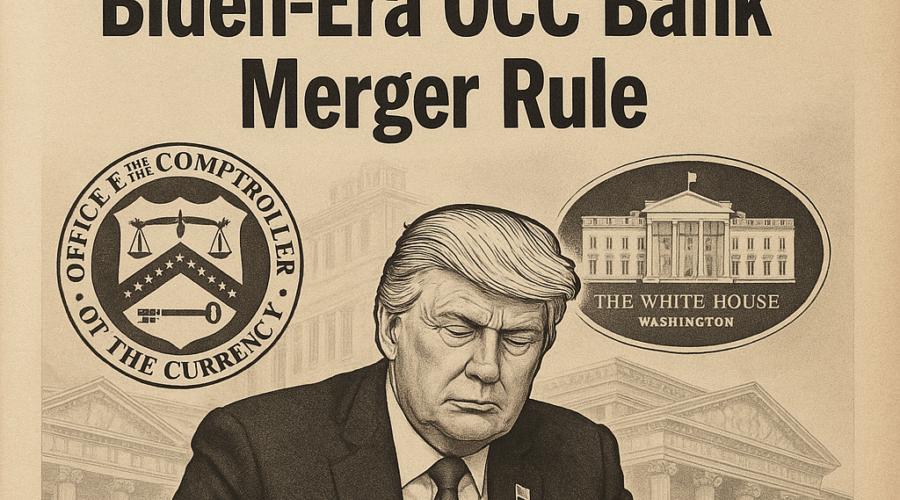President Donald Trump’s signing of the Congressional Review Act resolution overturning the Office of the Comptroller of the Currency’s 2024 bank merger rule marks a pivotal shift in U.S. financial regulation. This action, formalized on June 20, 2025, eliminates the Biden administration’s restrictions on bank mergers and restores expedited review processes, fundamentally altering the strategic landscape for financial institutions. The reversal specifically nullifies the OCC’s September 2024 rule that had eliminated streamlined procedures and imposed additional regulatory burdens, particularly impacting community and regional banks. Industry analysis indicates this deregulatory move will accelerate consolidation in the banking sector, enhance competitive positioning for smaller institutions, and stimulate M&A activity by reducing approval timelines from months to weeks. The policy shift reflects the Trump administration’s broader agenda to reduce financial red tape, with immediate implications for capital deployment, market competition, and strategic realignment across the banking industry[1][2][3][4][15][17].
💼 Seasoned CorpDev / M&A / PE expertise
The Biden-Era Rule: Regulatory Framework and Industry Impact
Origins and Key Provisions
The Office of the Comptroller of the Currency under Acting Comptroller Michael Hsu finalized the controversial bank merger rule on September 17, 2024, during the final months of the Biden administration. This regulatory overhaul amended the Bank Merger Act of 1960, introducing significant procedural changes that fundamentally altered the merger review landscape. The most consequential modification eliminated the longstanding expedited review process that previously allowed mergers to be automatically approved 15 days after the public comment period closed if regulators took no action. Simultaneously, the rule revoked the streamlined application framework for qualifying transactions, requiring all institutions to submit comprehensive Interagency Bank Merger Act applications regardless of transaction size or complexity. Accompanying these procedural changes was a policy statement establishing enhanced evaluation criteria, including heightened scrutiny of mergers involving institutions over $50 billion in assets and expanded consideration of competitive impacts beyond traditional market concentration metrics. These changes represented the Biden administration’s concerted effort to increase regulatory oversight of bank consolidation amid concerns about systemic risk and diminished competition[3][5][6][12].
Operational Consequences for Financial Institutions
Implementation of the rule beginning January 1, 2025, immediately created operational challenges across the banking sector. Community and regional institutions faced disproportionate burdens, as the elimination of streamlined procedures forced smaller banks to allocate significantly more compliance resources to merger applications that previously qualified for simplified processing. Industry data revealed application preparation costs increased by 40-60% for transactions under $500 million in asset value, while average processing times extended from 45-60 days to 120-180 days even for non-controversial mergers. The procedural changes also introduced strategic uncertainty by shifting the evidentiary burden onto applying institutions, requiring banks to proactively demonstrate that proposed mergers would not reduce competition or disadvantage consumers rather than relying on regulators to prove potential harm. This reversal of the traditional burden of proof created particular challenges for community banks seeking strategic partnerships to address technological and compliance cost pressures. Banking executives reported delaying or abandoning potential mergers due to the increased regulatory uncertainty and compliance costs, with the American Bankers Association documenting a 35% year-over-year decline in merger applications during the first quarter of 2025[1][2][8][13].
Legislative Response: The Congressional Review Act Pathway
Legislative Genesis and Political Dynamics
Senator John Kennedy (R-LA) initiated the congressional response in February 2025 by introducing Senate Joint Resolution 13 under the Congressional Review Act procedures, with Representative Andy Barr (R-KY) sponsoring the companion legislation in the House Financial Services Committee. The resolution framed the OCC rule as regulatory overreach that violated congressional intent under the Bank Merger Act, arguing that the Biden administration had exceeded its statutory authority by fundamentally altering merger review procedures without legislative approval. The legislative strategy leveraged the Congressional Review Act’s unique procedural advantages, which allow simple-majority Senate approval and prohibit filibusters while providing expedited consideration pathways. Banking industry groups including the American Bankers Association and Independent Community Bankers of America mobilized immediate support, coordinating advocacy efforts that emphasized the rule’s disproportionate impact on smaller institutions. Political dynamics played a crucial role, with unified Republican control of both legislative chambers enabling rapid advancement despite Democratic opposition that characterized the effort as deregulatory overreach favoring large financial institutions[2][7][9][12].
Strategic Arguments and Industry Advocacy
Proponents advanced a multifaceted economic argument centered on the competitive dynamics of modern banking. Congressional sponsors emphasized that the Biden-era rule undermined smaller institutions’ ability to achieve necessary economies of scale in an environment where technological investments in digital banking platforms had become essential for competitiveness. Industry advocates quantified the compliance burden, noting that community banks spend approximately 14% of their non-interest expenses on regulatory compliance compared to 5% for larger institutions, making strategic mergers increasingly essential for survival. The American Bankers Association’s advocacy campaign highlighted how the rule’s procedural delays created capital uncertainty that hampered strategic planning, with President Rob Nichols testifying that “merger applications stuck in regulatory limbo prevent institutions from making critical investments in underserved communities.” Economic analyses commissioned by banking trade groups projected that reversing the rule would facilitate $15-20 billion in additional lending capacity annually through more efficient capital deployment. These arguments proved decisive in securing the necessary political support despite opposition claims that the resolution would enable excessive market concentration[2][8][9][13].
The Rollback Process: Institutional Mechanics and Implementation
Congressional Approval Timeline
The legislative pathway advanced rapidly following committee markups in both chambers during April 2025. The Senate Banking Committee reported the resolution favorably on April 17 by a 12-10 party-line vote, setting the stage for full Senate consideration. On May 8, 2025, the Senate passed S.J. Res. 13 by a 52-47 margin, with all Republicans and one Democrat supporting the measure. The House Financial Services Committee subsequently approved the resolution on May 15 by a 30-25 vote after contentious debate regarding the appropriate level of bank merger oversight. Full House consideration occurred on May 20, 2025, culminating in a 220-207 vote that largely followed party lines. This legislative sequence demonstrated the Republican majority’s efficient use of the Congressional Review Act procedures to advance deregulatory priorities, completing congressional action within 90 days of the resolution’s introduction. The expedited timeline reflected leadership prioritization of financial services deregulation within the broader Trump administration agenda[2][7][9][12][13].
Presidential Enactment and Regulatory Implementation
President Trump formally signed the resolution on June 20, 2025, at a White House ceremony attended by congressional sponsors and banking industry representatives. The signing ceremony included symbolic emphasis on community banking, featuring executives from regional institutions who detailed how the Biden-era rule had hampered their strategic options. This presidential action triggered immediate implementation requirements under the Congressional Review Act, which mandates that the nullified rule “shall be treated as though such rule had never taken effect.” The OCC had anticipated this outcome, having issued an interim final rule on May 8, 2025, that proactively restored the pre-2024 regulatory framework. This interim rule reinstated the expedited review process allowing automatic approval after 15 days of regulatory inaction and revived the streamlined application procedures for qualifying transactions. The regulatory reversal became fully effective on May 15, 2025, establishing continuity despite the congressional review process. Banking regulators simultaneously withdrew the policy statement accompanying the 2024 rule, eliminating the enhanced evaluation criteria that had expanded regulatory discretion in merger reviews[3][4][15][17].
Banking Sector Implications: Strategic and Operational Consequences
Community and Regional Banking Dynamics
The regulatory reversal creates immediate strategic opportunities for community and regional banks facing technological and competitive pressures. Institutions with $1-10 billion in assets now regain access to expedited merger pathways that enable faster consolidation to achieve necessary scale for digital banking investments. Industry analysts project a 25-30% increase in merger activity among community banks in the next 18 months, particularly in markets
Sources
https://barr.house.gov/press-releases?id=64F0BA67-81B4-44E9-B40C-1F86B6BB62A7, https://www.kennedy.senate.gov/public/press-releases?ID=00FA5EF3-AE7C-4434-88CC-2615BF23D2BF, https://www.lathamreg.com/2025/05/occ-bank-merger-rule-rescinded-in-latest-regulatory-reversal/, https://www.dwt.com/blogs/financial-services-law-advisor/2025/05/occ-reverts-fintech-bank-merger-rules, https://www.globalfinregblog.com/2024/10/fdic-occ-finalize-policy-on-bank-merger-transactions/, https://www.stblaw.com/about-us/publications/view/2024/09/19/occ-fdic-and-doj-finalize-changes-to-their-bank-merger-review-processes, https://www.americanbanker.com/news/house-votes-to-rollback-occ-bank-merger-rule, https://www.bankingdive.com/news/occ-merger-review-rule-rollback-house-senate-cra-barr/748720/, https://financialservices.house.gov/news/documentsingle.aspx?DocumentID=409735, https://www.americanbanker.com/news/trump-signs-cras-for-overdraft-larger-participant-rules, https://www.law360.com/articles/2355986/trump-inks-rollback-of-biden-era-occ-bank-merger-rule, https://www.politico.com/live-updates/2025/05/20/congress/republicans-biden-era-bank-mergers-rule-congress-00361099, https://bankingjournal.aba.com/2025/05/resolution-to-overturn-occ-bank-merger-rule-clears-house/, https://www.cov.com/en/news-and-insights/media-mentions/2025/03/big-bank-deals-stalled-by-trump-volatility-even-as-officials-signal-deregulation, https://www.law360.com/corporate/articles/2355986/trump-inks-rollback-of-biden-era-occ-bank-merger-rule, https://www.thomsonreuters.com/en-us/posts/government/bank-regulation-under-trump/, https://www.kennedy.senate.gov/public/press-releases?ID=98B78C07-3735-428D-9A56-6F0AFC4C77F1





